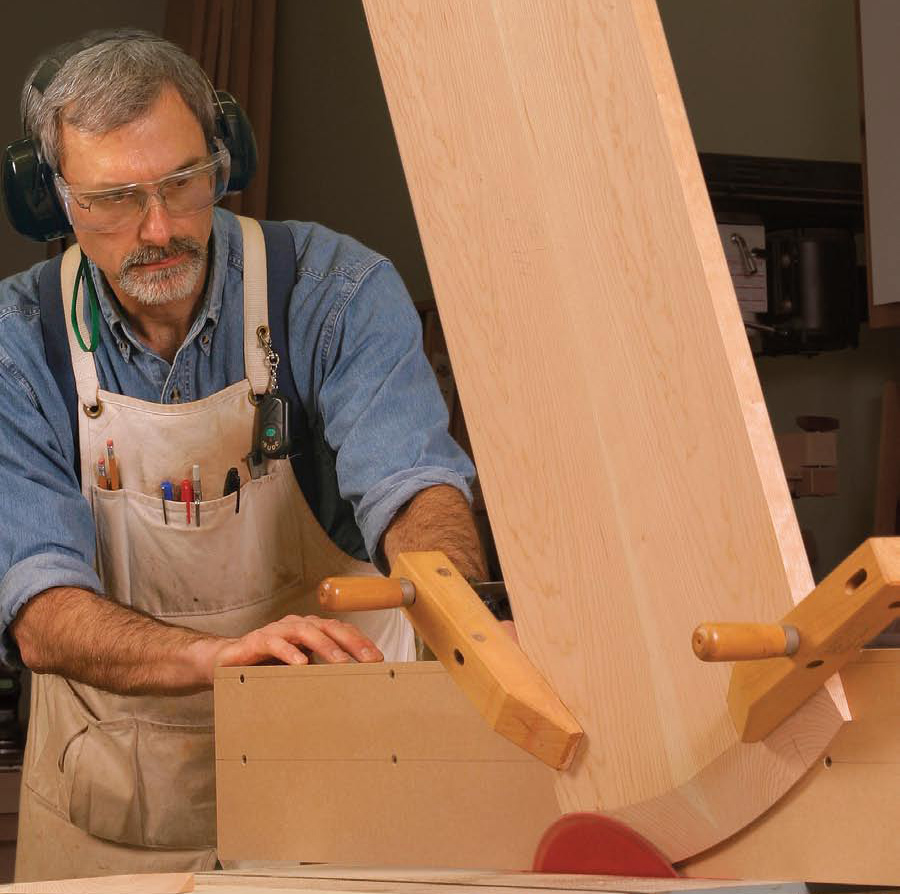Beveling curved edges can be tricky. You can do it with a router bit, but that limits the size of the bevel you can cut. You can do it with a shaper, but they’re expensive.
That’s why we were impressed when Geoffrey Carson submitted an article proposal for cutting wide bevels using a modified panel-raising fence on the tablesaw.
You can read all about it in Carson’s article in the latest issue of Fine Woodworking (the Jan/Feb issue, #217).
You can also watch this short slideshow/video to see the jig in action and to also see how it works on round tabletops, not just curved edges as discussed in the magazine.
Note: Pardon the delay in publishing this video. It was not available when the issue arrived in subscriber’s homes.























Comments
This is one of those cases where it seems like a sharp handplane trumps the power tool option...
-Steve
Way to go! There is nothing like inspiration that says "don't let not having all of the tools limit what you can do".
Hi
this is a convenien/smart and cheep solution of a problem, espetially if one doesn´t have any hurry.
Jiri
Looks like a solid and safe procedure.
It seems this forum regularly discusses tablesaw safety and misuse, the Saw Stop tablesaw and law suits over missing digits. Now we are seeing a procedure which requires the removal of the crown guard and riving knife (splitter) and the precarious balancing of a large board, on end, on a piece of veneer. The saddle over the fence could be pulled over by weight of such a large vertical board. This guy might get away with this procedure in his own shop, but for heavens sake, he should keep it to himself. I don't doubt some inexperienced woodworker will try the same with a large dining table top and the consequenses will be dire.
A bearing guided router cutter to remove the bulk of the waste and a sharp handplane would do the same job in less time, with the table top lying safely on the bench. Not using crazy techniques does not limit creativity, either.
Be safe.
Mike.
I would think you could use a circular saw instead. Put the table top on some saw horses; build a simple jig that would keep the saw perpendicular to the top of the table, set the blade to the desired bevel angle and simply walk around the table top. Because you are continuously moving the saw, you'll have less sanding and I think it's a far less awkward setup.
-Mike
Seems to me this is no more dangerous than using a tenoning jig with longer boards. The wood is securely clamped to the fence and is vertical so there should be little tendency to tilt into the blade. This tendency can be completely mitigated by maintaining downward pressure on the fence - which he does.
Also, while I'm a fan of hand tools, not sure this amount of wood could be removed as quickly with a plane. Likewise, doing it on a router table (which would be my preference) will take 3-4 passes to remove that volume of wood in addition to a $100 panel-raising bit.
Beauty in the eye of the beholder... Safety relative to the doer. The technique looks like one I'll keep in mind/on file. If you're a klutz, do not take a racing motorcycle to a track on weekends for recreation. Probably, you shouldn't try mountain climbing. Evaluate your coordination and stay a little on the safe side so you can keep doing your thing into old age. Some people should not use this technique. Some people should never use a table saw less safe than a Saw Stop. Damned if I'd pay the money for this device. After more than fifty years on the table saw, I'll take my chances. I think his technique can be classified as a responsible presentation. Use your own discretion.
Sincerely,
Robert H. Galloway
It seems to me that you could just rotate the table top into the blade enstead of stoping the saw each time. I have done this making curved raised pannals before.
Log in or create an account to post a comment.
Sign up Log in